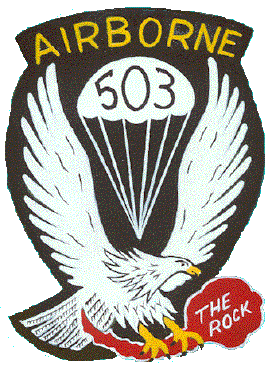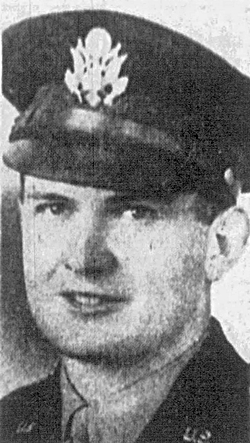|
EMORY N. BALL
_________________
















|

Emory N. BALL
2nd Lieut 'E' Company.
K.I.A., Wheeler Pt. - 23
February 1945

Emory N. Ball, photo courtesy Todd
Mayer |
|
 Ball was killed along the road towards the tunnel entrance behind Battery Monja. With his advanced elements well forward of Hill's position and heavily engaged with
the Japanese who were rushing out of the caves in groups, Roscoe Corder was bringing more men forward to lie on the road, seeking what shelter they
could find. They were also under heavy rifle fire and, possibly, machine gun fire by now. Corder and Ball were still behind the dirt pile close enough to touch each other.
Corder moved a little to the left, and Ball raised up to look at the entrance. Immediately, he was shot in the chest. Corder
saw the dust fly from the back of Ball's fatigues where the bullet exited. Ball fell beside Corder. Doc Bradford, who had come forward to Corder’s
position, examined Ball, looked first at the entry wound in the chest and, Corder says, "slapped a piece of tape over it." He turned Ball over, examined the exit
wound, and "slapped a piece of tape over it." Shortly, Ball looked up at his friend and, to quote Corder,
"He looked me in the eye.., and died." Ball was killed along the road towards the tunnel entrance behind Battery Monja. With his advanced elements well forward of Hill's position and heavily engaged with
the Japanese who were rushing out of the caves in groups, Roscoe Corder was bringing more men forward to lie on the road, seeking what shelter they
could find. They were also under heavy rifle fire and, possibly, machine gun fire by now. Corder and Ball were still behind the dirt pile close enough to touch each other.
Corder moved a little to the left, and Ball raised up to look at the entrance. Immediately, he was shot in the chest. Corder
saw the dust fly from the back of Ball's fatigues where the bullet exited. Ball fell beside Corder. Doc Bradford, who had come forward to Corder’s
position, examined Ball, looked first at the entry wound in the chest and, Corder says, "slapped a piece of tape over it." He turned Ball over, examined the exit
wound, and "slapped a piece of tape over it." Shortly, Ball looked up at his friend and, to quote Corder,
"He looked me in the eye.., and died."
Bill Calhoun
 Emery was the 2nd
Lieut for
"E" Co's Mortar Platoon. The platoon was left on
topside for some unknown reason when the rifle platoons attacked Battery Monja. Emery went along when he didn't need to.
I did not see him hit but Roscoe Corder told me that
Ball, for some reason, stood up and was hit in the
chest. He slipped over the side of the road and slid down the steep slope. The next day Corder took a detail down for his
body but it could not be found. Emery was the 2nd
Lieut for
"E" Co's Mortar Platoon. The platoon was left on
topside for some unknown reason when the rifle platoons attacked Battery Monja. Emery went along when he didn't need to.
I did not see him hit but Roscoe Corder told me that
Ball, for some reason, stood up and was hit in the
chest. He slipped over the side of the road and slid down the steep slope. The next day Corder took a detail down for his
body but it could not be found.
Hill
told me that Lt. Emory Ball had followed the 2nd Platoon along the road
(towards Btty. Monja) and had been
firing on the tunnel entrances along with the enlisted men from the platoon. I don't know
what Ball was doing there since his Mortar platoon had remained at topside. As Hill
watched, Ball stood up and caught several round in the chest and stomach. Ball was dead
before he hit the ground.
Don Abbott
 Ball was one of two troopers killed
in a which erupted near the mouth of Cheney ravine. At dusk the
troopers of Company E dug in for the night, having failed to retrieve
the bodies of their two fallen comrades because of the intensity of enemy
fire. The following morning patrols into the previous evening’s
battle area discovered that the bodies of 2d Lt. Emory N. Ball and Pvt
Jandro were gone. They could only surmise that the Japanese had carted
away the American corpses along with their own dead during the night.
Whether the dead troopers were taken to a cave for burial or to the sea for
the high tide to carry them away remains unknown. Ball was one of two troopers killed
in a which erupted near the mouth of Cheney ravine. At dusk the
troopers of Company E dug in for the night, having failed to retrieve
the bodies of their two fallen comrades because of the intensity of enemy
fire. The following morning patrols into the previous evening’s
battle area discovered that the bodies of 2d Lt. Emory N. Ball and Pvt
Jandro were gone. They could only surmise that the Japanese had carted
away the American corpses along with their own dead during the night.
Whether the dead troopers were taken to a cave for burial or to the sea for
the high tide to carry them away remains unknown.
Bennett M. Guthrie

|
![]()